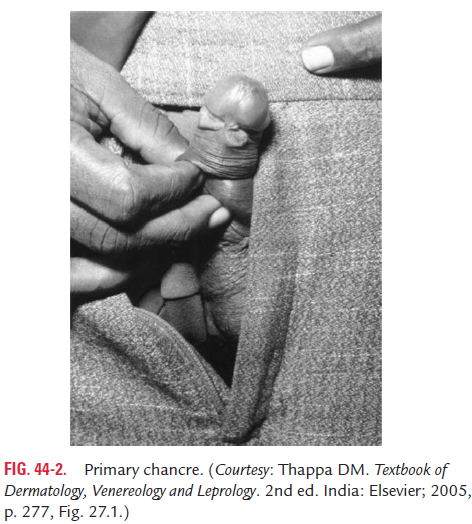Chapter: Microbiology and Immunology: Bacteriology: Treponema, Borrelia and Leptospira
Clinical Syndromes - Treponema pallidum
Clinical Syndromes
pallidum causes following clinical syndromes:
1. Venereal syphilis (transmitted by sexual contact)
2. Nonvenereal syphilis (congenital syphilis and occupational syphilis)
◗ Venereal syphilis
Syphilis, if remains untreated, progresses through these dis-tinct characteristic stages as follows:
Primary syphilis: This condition occurs within 3 weeks ofsexual contact with an infected host. Chancre is the primary lesion seen during this stage of the disease (Fig. 44-2). It is a single or solitary lesion with a surrounding areola. The edge and base of the ulcer have a button-like consistency on pal-pation. The lesion occurs on penis or on scrotum of 75% of men and on the vulva, cervix, or perineum of more than 50% of women suffering from syphilis. The chancre is highly infec-tious. The exudates of the chancre contain numerous T. pal-lidum bacteria.

Secondary syphilis: Secondary syphilis occurs 2–10 weeksafter the primary chancre and is most florid 3–4 months after infection. This stage of the disease is characterized by the presence of mucocutaneous lesions, which are discrete, macu-lar pink to red, and measure 3–10 mm in diameter.
The cutaneous lesions may vary from macular to papular, pustular, and nodular type. The papules in the moist area of the skin of the body folds, especially about the anus (Color Photo 49) and genitalia, subsequently become broad, flat, and pink in color, leading to the formation of so-called condylomata lata. The lesions are found in the entire body including the palms, sole, and other sites.
This condition is associated with mild symptoms of head-ache, nausea, fever, and pain in the bones. Painless generalized lymphadenopathy is seen in nearly 85% of the patients
Tertiary syphilis: The condition develops within 3–10 yearsof infection. Gumma is a typical pathological lesion found on the skin, in the mouth, and in the upper respiratory tract. Gummatous lesions may be multiple or diffuse, but are usually single lesions, which measure from 1 cm to sev-eral centimeters in diameter. This tertiary lesion contains few spirochetes and represents manifestations of delayed hypersensitivity.
Cardiovascular syphilis, chronic granulomatous and menin-govascular manifestations, and neurosyphilis (Tabes dorsalis, general paralysis of insane) are the other manifestations of syphilis, which occur several decades after the infection.
◗ Nonvenereal syphilis
Congenital syphilis and occupational syphilis are example of nonvenereal syphilis.
Congenital syphilis: It is the most severe outcome of syphilisin humans. The infection occurs by vertical transmission from mother to fetus during pregnancy. If the mother is suffering from secondary syphilis and not treated for the same, a higher proportion of infants are affected compared to untreated early latent syphilis. In more than 40% of untreated mater-nal infection, T. pallidum causes late abortion, still birth, and death. Deaths in neonates may occur due to secondary bacte-rial infection, fulminant hepatitis, or pulmonary hemorrhage.
The infants suffering from congenital syphilis are born usually without any overt clinical manifestation of the disease. Poor feeding and rhinitis may be the earliest signs of congeni-tal syphilis. Manifestations of the late onset congenital syphilis include neurosyphilis and involvement of the eighth cranial nerve, teeth, and bones.
Occupational syphilis: It is a condition that may occur inmedical and paramedical workers handling a case of secondary syphilis. The lesion develops usually on the palm of infected health workers and may also occur on other exposed body part.
Related Topics